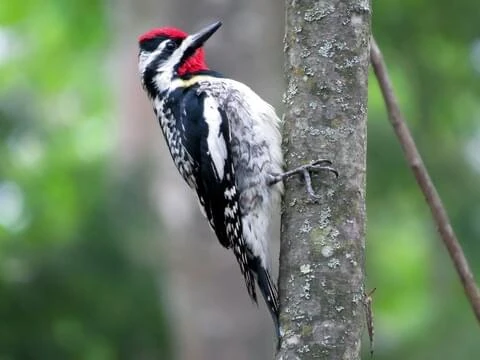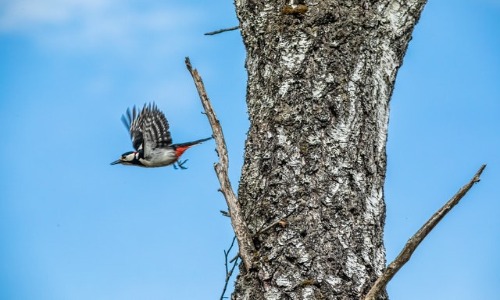In addition to excavating cavities, woodpeckers have a signature flight pattern and many other fascinating behaviors like a distinctive climbing posture and a signature flight style known as flap-bounding flight.
Nonetheless...
Do woodpeckers migrate? It might be a question many of us are eager to know. Due to the diversity of woodpecker species worldwide, each species will have its distinct ways of living.
If you'd like to know whether or not woodpeckers migrate, please continue reading, and let's find out.
A. Migratory Woodpeckers And Their Migration Patterns
Most woodpeckers are highly sedentary while other woodpeckers go through regular seasonal migrations. Some woodpeckers keep themselves warm in winter by staying in their roosting cavities instead of migrating.
Bird migration is more than just moving from one place to another. Birds migrate when they're foraging, gathering nest materials, fleeing predators, looking for water sources, or pursuing intruders.
Check out what woodpecker species are migratory. By learning more about their behavior and such movements, we will better understand our ecosystem.
1. Northern Flicker

Northern flickers are short-distance travelers that migrate south in winter from their northern ranges in North Carolina and the western regions to the Rocky Mountains. You will have no trouble identifying a northern flicker in flight; look for its white rump patch that is more conspicuous as the bird flies.
Despite its range extending from North and Central America, northern flickers also breed from Alaska and Canada. Though a northern flicker is sedentary in Cuba and Grand Cayman, those from the northernmost parts are migratory and even travel as far as Mexico in winter.
2. Lewis’s Woodpecker

Lewis's Woodpeckers currently suffer from habitat loss and decline in many areas. Such species display opportunistic behavior regarding food resources; they can be cunning in their migratory distance, pattern, and timing.
However, there is a need to review the conservation status of these woodpeckers; various organizations exert effort to preserve Ponderosa pine forests, Lewis's natural habitat.
A Lewis's woodpecker from the northernmost regions may move more than 1000 kilometers, but those on the Pacific Coast remain near breeding grounds year-round. Resident species spread depending on food sources.
It breeds at high elevations in southwestern Canada to the western edge of the Great Plains, New Mexico, and northern Arizona. Several flocks merge and wander in fall, occasionally in winter.
3. Red-Headed Woodpecker

The population of a red-headed woodpecker can be pretty tricky to determine since its population naturally fluctuates according to food availability.
When the once-abundant northern beech forests yielded generous produce, the red-headed woodpecker population was at its peak, even during the irruption of the Rocky Mountain grasshopper. But now, despite its long-term decline, red-headed woodpeckers remain common in the western Midwest and on the Great Plains.
4. Yellow-Bellied Sapsucker

The yellow-bellied sapsucker is another woodpecker experiencing local declines. It has an extensive breeding range in eastern Alaska across northern Canada, generally decreasing in abundance southwards. Likewise, this bird breeds in the eastern parts of North America, from Massachusetts northward, then the species migrate south in winter and autumn.
You will encounter wintering female yellow-bellied sapsuckers in Cuba's coconut palms after fleeing the cold in Canada to enjoy the Caribbean sun and Central America. However, this migratory bird is an irregular visitor in Panama and Colombia.
Such birds are frequent in forest edges and open woodlands, favoring rolling hills rich in hickory and oaks, preferably roosting in deciduous trees. Moreover, yellow-bellied sapsuckers feed on fruits, ants, and other insects.
5. Red-Naped Sapsucker

The red-naped sapsucker typically breeds about 5000 to 10,000 feet high, like the forests in the Intermountain West. Its range extends from the Rocky Mountains westward to the eastern slopes of Washington and Oregon Cascades.
Red-naped sapsuckers are among the birds that migrate short distances, with their females traveling farther than males.
Northern birds migrate to southern parts of California, Arizona, and New Mexico during the colder months. You will likely encounter this bird in aspen groves, montane riparian areas, and other wetlands, with surrounding cottonwood, willow, sumac, or birch trees.
It is well-adapted to various environments, often moving across foothills and valleys, performing altitudinal movements during fall migration in August.
B. Non-Migrating Woodpeckers
Not all woodpeckers you are familiar with already are migratory. Some settle down comfortably in a locale of their choosing and reside there. The following are common woodpeckers that are non-migratory:
1. Pileated Woodpecker

The pileated is a permanent resident of the mature forests throughout its range. It's primarily sedentary with some seasonal movements; such species occur on the Pacific Coast from Oregon, decreasing in numbers in California.
Since it's a non-migratory bird, an overwintering pileated woodpecker typically forages seeds and crawling insects, mainly carpenter ants and bugs, hiding within dead trees.
2. Downy Woodpecker

The downy, just like the hairy woodpecker, is also non-migratory. You can distinguish the hairy woodpecker with its shorter bill and smaller body size. The downy woodpecker is generally sedentary but moves into unoccupied habitats when breeding and regularly visits bird feeders.
3. Red-bellied Woodpecker

Red-bellied woodpeckers are abundant throughout the eastern half of the United States, love feeding insects, and are common in suburban and urban woods. The red-bellied woodpecker doesn't have a red belly as its name implies, but it has an entirely red head and nape.
Despite its non-migratory status, a red-bellied woodpecker sometimes wanders post-breeding, exploring the limits of its range in fall and winter. Similar to the American Three-toed Woodpecker, the black-backed woodpecker is also prevalent in expansive boreal forests.
4. Black-backed Woodpecker

The black-backed woodpecker does not migrate, although it sometimes moves south of its breeding territories in fall into the northern Great Plains and Mid-Atlantic.
5. Three-toed Woodpecker

The American Three-toed Woodpecker, a non-migrating bird, lives in the mountainous West of Arizona and New Mexico.
Birdhub Speak: I believe you already caught wind of the woodpeckers' migratory habits. We're not done yet, though! Fly by this post -- Minnesota Woodpeckers.
Watch This!
Frequently Asked Questions
How do woodpeckers survive in winter?
Woodpeckers are well-equipped for the colder months. These birds have solid bills and tree-clinging skills, helping downy and hairy woodpeckers forage for wood-boring larvae and carpenter ants for the pileated woodpeckers.
Such birds are well-known for spring and winter excavations, particularly the pileated woodpecker, staying within its range and drilling tree cavities in mature forests. A downy woodpecker keeps itself warm in winter by roosting in cavities of dying or dead trees.
Do woodpeckers return to the exact location?
Woodpeckers stick around and return to the same spot with abundant sources of food and nesting. Nevertheless, other species opt for new nesting grounds in spring, while some woodpeckers reuse old nests.
Bird species that go back to the same spot to roost are acorn and red-headed woodpeckers. On the contrary, hairy woodpeckers, pileated woodpeckers, and downy woodpeckers prefer new nests yearly.
Is it common for woodpeckers to hibernate?
Migration occurs when birds look for better opportunities in terms of survival or reproduction than if they stay in the exact location throughout the year. Some creatures resort to migrating while other birds spend increased periods in nesting sites that make them unavailable to predators.
However, unlike other species that stay dormant, woodpeckers do not hibernate. Some birds join flocks, move to warmer climates, or resort to other practices to conserve energy during frigid weather. But these woodpeckers are not the type to overstay in their nests to survive.
Read Also: Best Woodpecker Feeders
Conclusion
We can learn much about climatic conditions from bird migration. There's more to these migrations than merely witnessing various flight patterns and graceful movements. Many of our native woodpeckers in the United States do not move even in winter. But some shift from one nesting ground to another when the temperatures change.
Once we learn more about climate change, we have better opportunities to manage wildlife populations more efficiently. Different species respond differently to such changes, and the bird population may evolve.
We can help these woodpeckers that prefer to stay even as the season changes by providing them with their basic needs. A simple act such as providing them with food supply, water, and shelter can go a long way towards their preservation.
